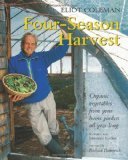October Garden Calendar
Zone 1
- Finish planting container-grown trees and shrubs
- Plant needle-bearing evergreens early in the month
- If the month is dry, repeat the September soaking
- Check ties on trees, and loosen any that look tight
- Finish bulb planting early in the month
- Cover compost to keep it warm and working
- Observe trees for fall color; jot names of the best in your notebook
- Dig dahlia roots after tops are frosted
Zone 2
- Spred maure on the rows where you will be planting early peas net spring. While there may be a bit of loss of nutrients from leaching, turn the
manure under, but leave the earth rough and cover with straw to keep erosion at bay.. You will be able to plant peas during an early thaw by pulling the hay to one side.
- Cut back on feeding houseplants (do not feed dormant houseplants)
- Protect roses for winter
Zone 3
- Spred maure on the rows where you will be planting early peas net spring. While there may be a bit of loss of nutrients from leaching, turn the
manure under, but leave the earth rough and cover with straw to keep erosion at bay.. You will be able to plant peas during an early thaw by pulling the hay to one side.
- Start fall compost pile
- Cover perennial, vegetable, bulb, and strawberry beds for winter
- Plant winter- and spring-flowering bulbs
- Divide and replant crowded fall-blooming bulbs after leaves yellow
- Cut back on feeding houseplants (do not feed dormant houseplants)
- Protect roses for winter
Zone 4
- Spread maure on the rows where you will be planting early peas net spring. While there may be a bit of loss of nutrients from leaching, turn the manure under,
but leave the earth rough and cover with straw to keep erosion at bay.. You will be able to plant peas during an early thaw by pulling the hay to one side.
- Start fall compost pile
- Work summer's completed compost into empty beds before fall rains begin.
- Cover perennial, vegetable, bulb, and strawberry beds for winter
- Plant winter- and spring-flowering bulbs
- Divide and replant crowded fall-blooming bulbs after leaves yellow
- Buy spring-blooming bulbs
- Plant container and balled-and-burlapped fruit trees
- Cut back on feeding houseplants (do not feed dormant houseplants)
- Plant, feed, and aerate cool-season lawns and loosen thatch
- Sow seeds for frost-tolerant perennials
- Divide and replant summer- and fall-blooming perennials after bloom
- Protect roses for winter
- Plant summer-blooming shrubs and vines
- Plant balled-and-burlapped trees
- Plant trees in containers
- Plant frost-tolerant trees
Zone 5
- Start fall compost pile
- Work summer's completed compost into empty beds before fall rains begin.
- Spread maure on the rows where you will be planting early peas net spring. While there may be a bit of loss of nutrients from leaching, turn the manure under,
but leave the earth rough and cover with straw to keep erosion at bay.. You will be able to plant peas during an early thaw by pulling the hay to one side.
- Plant winter- and spring-flowering bulbs
- Divide and replant crowded fall-blooming bulbs after leaves yellow
- Buy winter- and spring-blooming bulbs
- Plant container and balled-and-burlapped trees fruit trees
- Cut back on feeding houseplants (do not feed dormant houseplants)
- Plant cool- and warm-season lawns
- Aerate cool-season lawns and loosen thatch
- Sow seeds for frost-tolerant perennials
- Divide and replant summer- and fall-blooming perennials after bloom
- Plant container roses
- Protect roses for winter
- Plant container and balled-and-burlapped trees, shrubs, and vines
- Plant summer-blooming shrubs and vines
- Plant frost-tolerant trees
Zone 6
- Work summer's completed compost into empty beds before fall rains begin.
- Spread maure on the rows where you will be planting early peas net spring. While there may be a bit of loss of nutrients from leaching, turn the manure under,
but leave the earth rough and cover with straw to keep erosion at bay.. You will be able to plant peas during an early thaw by pulling the hay to one side.
- Start fall compost pile
- Plant winter- and spring-flowering bulbs
- Divide and replant crowded fall-blooming bulbs after leaves yellow
- Buy winter- and spring-blooming bulbs
- Plant container and balled-and-burlapped fruit trees
- Plant permanent ground covers
- Cut back on feeding houseplants (do not feed dormant houseplants)
- Plant and aerate lawns and loosen thatch
- Sow seeds for frost-tolerant perennials
- Divide and replant summer- and fall-blooming perennials after bloom
- Plant container roses
- Protect roses for winter
- Plant container and balled-and-burlapped trees, shrubs, and vines
- Plant summer-blooming shrubs and vines
- Plant frost-tolerant trees
- Plant needle-leafed evergreens
Zone 7
- It can, of course, be a "crap shoot" here in zone 7 to take a chance on a "good" winter. One never knows... does one?
If you're feeling good about it, plant beans, eggplant, and tomatoes for very early crops.
Portable cold frames will give you extra insurance if the weather goes bad or if your area is not completely frost free. They
don't have to be fancy or expensive, just effective. ;)
- Plant or repair lawns
- Plant ornamental grasses
- Cover perennial, vegetable, bulb, and strawberry beds for winter
- Plant winter- and spring-blooming bulbs
- Pre-chill tulips and hyacinths for indoor forcing
- Plant balled-and-burlapped or container fruit trees
- Cut back on feeding houseplants (do not feed dormant houseplants)
- Rake lawn to remove debris
- Sow seeds for frost-tolerant perennials
- Plant container roses
- Plant balled-and-burlapped or container trees, shrubs, and vines
- Prune fall-flowering shrubs just after bloom
- Protect tender plants from frost
Zone 8
- Plant for fall and winter color
- Plant winter- and spring-blooming bulbs
- Plant balled-and-burlapped and container fruit trees
- Prune frost-sensitive fruit trees
- Cut back on feeding houseplants (do not feed dormant houseplants)
- Plant or repair lawns
- Plant ornamental grasses
- Sow seeds for frost-tolerant perennials
- Plant fall- and winter-blooming perennials
- Prune fall-blooming shrubs and vines just after bloom
- Plant seedlings of cool-season or winter vegetables
- Sow seeds for cool-season or winter vegetables
Zone 9
- Plant for fall color with annuals
- Buy winter- and spring-blooming bulbs
- Feed and water cacti or succulents that are growing or blooming
- Feed houseplants that are growing or bloomin
- Repair or plant lawns
- Rake lawns to remove debris
- Sow frost-tolerant perennials indoors
- Plant fall- and winter-blooming perennials
- Prune fall-flowering shrubs and vines just after bloom
- Plant or transplant seedlings of cool-season or winter vegetables
- Sow seeds for cool-season or winter vegetables
Zone 10
- Plant annuals for fall color
- Set out fall and winter-blooming plants
- Plant winter- and spring-blooming bulbs
- Feed and water cacti and succulents that are growing or blooming
- Feed houseplants that are growing or blooming
- Plant winter-blooming perennials
- Prune fall-flowering shrubs and vines after bloom
- Sow cool-season vegetable seeds
- Start seeds for cool-season or winter vegetables
Zone 11
- Finish planting spring-blooming bulbs
- Plant container-grown trees and shrubs
- Feed and water lawn to encourage overseeded grass
- Prune back summer- and fall-blooming shrubs
- Allow rose hips to form; it will encourage early dormancy in bushes
"There are no gardening mistakes, only experiments."
-- Janet Kilburn Phillips

FREE Garden Journal!!
Join "Garden Notes" and plan for Harvest Success as you track and record your gardening progress.
Your Free Personal Garden Journal has pages for jotting down notes on the seeds you start,
your new plantings, when you fertilized, and even a graph to plot a new garden.

FREE Report
If you're interested in growing tomatoes, you've got to read this free report, because you're about to find out
3 age-old, tried and tested, organic tomato growing secrets that turn any tomato plant into a thriving source of the
juiciest, most
mouth-watering tomatoes you've ever tasted.
I didn't want to see another internet "eBook" on growing anything, but my husband signed up for Kacper's free report and I have to tell you, it is WELL worth the read. If you think you know everything about growing tomatoes, I challenge you to read Kacper's report. HIGHLY recommended!
Free Report Here

What's New?
Discover How To Easily Build An Attractive And Affordable Greenhouse That Will Grow Anything In Any Conditions… Also, building your own greenhouse just makes economical sense. You can build a greenhouse at just a fraction of the cost of buying a pre-built one. Most pre-built greenhouse you buy need to be assembled anyway, you’re really just paying hugely inflated prices for the material.
Click Here!
Book of the Month

This book stays at GardenSimply as Garden Book of the month AGAIN. It has been my winter gardening bible and if you don't have it yet,
I am leaving it up for January. Perfect compliment book for the ebook listed above... A book full of valuable information on how to harvest fresh vegetables and salad
ingredients literally year-round--yet without an expensive greenhouse or indoor light garden set-up.
He includes how-tos for building simple cold-frames.
Read More...





